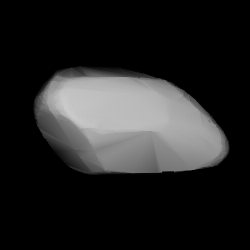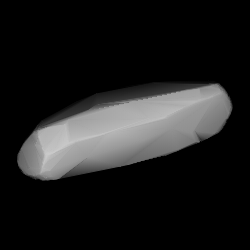
1500 Jyväskylä, provisional designation 1938 UH, is a stony Florian asteroid from the inner regions of the asteroid belt, approximately 7 kilometers in diameter. It was discovered on 16 October 1938, by Finnish astronomer Yrjö Väisälä at the Turku Observatory in Southwest Finland. It was named for the Finnish town Jyväskylä.
2348 Michkovitch, provisional designation 1939 AA, is a presumed carbonaceous Erigone asteroid from the inner regions of the asteroid belt, approximately 15 kilometers in diameter. It was discovered by Serbian astronomer Milorad Protić at Belgrade Observatory on 10 January 1939. The asteroid was named after Serbian astronomer Vojislav Mišković.

9983 Rickfienberg is a carbonaceous asteroid from the middle region of the asteroid belt, approximately 10 kilometers in diameter. It was discovered on 19 February 1995, by American astronomer Dennis di Cicco at his private Sudbury Observatory, Massachusetts, United States. It was named after American astronomer and editor Richard Fienberg.

9971 Ishihara is a stony Flora asteroid from the inner regions of the asteroid belt, approximately 5 kilometers in diameter. It was discovered by Japanese amateur astronomers Kin Endate and Kazuro Watanabe at Kitami Observatory on 16 April 1993, and named after Takahiro Ishihara, president of the astronomical society at Hiroshima.
2572 Annschnell, provisional designation 1950 DL, is a background asteroid from the inner regions of the asteroid belt, approximately 10 kilometers in diameter.
1651 Behrens, provisional designation 1936 HD, is a stony Florian asteroid from the inner regions of the asteroid belt, approximately 10 kilometers in diameter. Discovered by Marguerite Laugier in 1936, it was named after Johann Behrens.
2537 Gilmore, provisional designation 1951 RL, is a Eunomia asteroid from the middle region of the asteroid belt, approximately 7 kilometers in diameter. It was discovered on 4 September 1951, by German astronomer Karl Reinmuth at Heidelberg Observatory in southern Germany. It was named after New Zealand astronomer couple Alan C. Gilmore and Pamela M. Kilmartin
3099 Hergenrother, provisional designation 1940 GF, is an asteroid from the outer region of the asteroid belt, approximately 15 kilometers in diameter. It was discovered on 3 April 1940, by Finnish astronomer Yrjö Väisälä at Turku Observatory in Southwest Finland, and named after American astronomer Carl Hergenrother in 1996.
6395 Hilliard, provisional designation 1990 UE1, is a stony Nysian asteroid from the inner regions of the asteroid belt, approximately 4.5 kilometers in diameter.
23718 Horgos (provisional designation 1998 GO10) is a stony background asteroid from the central regions of the asteroid belt, approximately 2.9 kilometers in diameter. It was discovered on 2 April 1998, by Hungarian astronomers Krisztián Sárneczky and László Kiss at Konkoly's Piszkéstető Station northeast of Budapest, Hungary. The asteroid was named after the Serbian town of Horgoš.

2156 Kate is a highly elongated background asteroid from the inner regions of the asteroid belt. The asteroid was discovered on 23 September 1917, by Soviet–Russian astronomer Sergey Belyavsky at the Simeiz Observatory on the Crimean peninsula. It was named for Kate Kristensen, wife of astronomer L. K. Kristensen. The bright S-type/A-type asteroid has a rotation period of 5.6 hours and measures approximately 8 kilometers in diameter.
9223 Leifandersson, provisional designation 1995 YY7, is a background asteroid from the inner regions of the asteroid belt, approximately 4.5 kilometers in diameter. It was discovered on 18 December 1995, by astronomers of the Spacewatch program at Kitt Peak National Observatory in Arizona, United States. The asteroid was named in memory of Swedish astronomer Leif Erland Andersson. The assumed stony asteroid has a rotation period of 3.758 hours.

1906 Naef is a stony vestoid asteroid from the inner regions of the asteroid belt, approximately 7 kilometers in diameter. It was discovered on 5 September 1972, by Swiss astronomer Paul Wild at Zimmerwald Observatory near Bern, Switzerland. It was later named after Swiss banker and amateur astronomer Robert A. Naef.

2384 Schulhof (prov. designation: 1943 EC1) is a mid-sized asteroid and the namesake of the Schulhof family, located in the Eunomian region of the intermediate asteroid belt. It was discovered on 2 March 1943, by French astronomer Marguerite Laugier at Nice Observatory in southeastern France. The asteroid was later named after Hungarian astronomer Lipót Schulhof. The presumed S-type asteroid has a short rotation period of 3.3 hours and measures approximately 12 kilometers (7.5 miles) in diameter.

1648 Shajna, provisional designation 1935 RF, is a stony asteroid from the inner regions of the asteroid belt, approximately 9 kilometers in diameter. It was discovered on 5 September 1935, by Russian astronomer Pelageya Shajn at Simeiz Observatory on the Crimean peninsula. Two weeks later, it was independently discovered by Cyril Jackson at Johannesburg Observatory, South Africa. It was later named after the discoverer and her husband, Russian astronomers Grigory Shajn.
2956 Yeomans, provisional designation 1982 HN1, is a stony asteroid from the central regions of the asteroid belt, approximately 10 kilometers in diameter. It was discovered on 28 April 1982, by astronomer Edward Bowell at the Anderson Mesa Station of the Lowell Observatory in near Flagstaff, Arizona. It was named after American astronomer Donald Keith Yeomans.
2278 Götz, provisional designation 1953 GE, is a dark background asteroid from the inner regions of the asteroid belt's background population, approximately 12 kilometers in diameter. It was discovered on 7 April 1953, by German astronomer Karl Reinmuth at the Heidelberg Observatory in southwest Germany. The F/C-type asteroid was named after astronomer Paul Götz.
1461 Jean-Jacques, provisional designation 1937 YL, is a metallic asteroid from the outer region of the asteroid belt, approximately 34 kilometers in diameter. It was discovered on 30 December 1937, by French astronomer Marguerite Laugier at Nice Observatory in southern France, who named it after her son Jean-Jacques Laugier.
1530 Rantaseppä, provisional designation 1938 SG, is a stony Florian asteroid from the inner regions of the asteroid belt, approximately 5 kilometers in diameter. Discovered by Yrjö Väisälä at Turku Observatory in 1938, it was later named after Finnish astronomer Hilkka Rantaseppä-Helenius.
7449 Döllen, provisional designation 1949 QL, is a stony Florian asteroid from the inner regions of the asteroid belt, approximately 3.5 kilometers in diameter. It was discovered on 21 August 1949, by German astronomer Karl Reinmuth at the Heidelberg Observatory in southwest Germany. The likely S-type asteroid has a rotation period of 10 hours. It was named after German astronomer Wilhelm Döllen.







